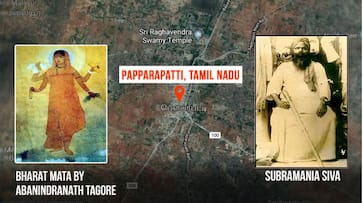Freedom fighter Subramania Siva's dream of a temple dedicated to Bharat Mata may finally come true in the small town of Papparapatti in Tamil Nadu. What took it so long despite the fact that neither land nor money for the project was an issue and there was never an overt opposition to the proposal from any quarter?
The last time one heard of Papparapatti in Dharmapuri district in Tamil Nadu was when the acclaimed Tamil movie, Joker, was released. Not only did the movie win the national award but it also won several hearts globally. It was an engaging and intensely moving experience to watch such a movie, which stayed with the viewer long after it was over.
There was a lesson or two in it for anybody and everybody. Leave aside the whole of India, in a large State like Tamil Nadu alone, there are so many minute, complex and incomprehensible problems that we are not aware of. Sitting in our cocoons, we will never understand what these problems are unless we get to the brass tacks. Second, there are also so many social activists, cutting across ideologies, giving their respective chosen causes their very best. They have moved out of their comfort zones with zero support. Yet they are laughed at or mocked. People don’t realise that these activists have risen above selfishness. Last but not the least, the movie is an ode to each and every one of them. Finally, there cannot be a better movie in Tamil for furthering the cause of clean living.
Another important reference with regard to the village of Papparapatti is the date October 18, 2004, when the words “File on Koose Muniswamy Veerappan closed” resonated. Papparapatti was in the news when Veerappan was shot dead near the village by Tamil Nadu’s formidable police officer K Vijay Kumar. The decade-long hunt for Veerappan came to an end near this significant village.
Papparapatti is now in news for a different, specific and important reason. A temple for Bharat Mata (Mother India), the wish of the late freedom fighter, Subramania Siva, is all set to become a reality soon at Papparapatti, after nearly a century of its seed being sown. Just imagine, the foundation stone for this temple was laid by the late freedom fighter, Deshbandhu CR Das, on June 23, 1923.
On June 25, 2018, Tamil Nadu’s Information Minister, Kadambur Raju, announced in the State Assembly that this temple would come up at an expenditure of Rs 1.5 crore. Decades ago, Subramania Siva purchased half an acre of land in Papparapatti for building this temple but he died before his dream could materialise. This goes to show the significant place that Indian culture gives to women. In this case, Siva, like several other freedom fighters, felt that Bharat Mata was the national personification of India as a goddess.
Every temple in India has its significance. Therefore, it is important to acquaint ourselves with the significance of the temple before visiting it, and also with the various stories related to it. For that, we must understand the importance of Subramania Siva, the firebrand revolutionary from Tamil Nadu. One of Subramania Bharati’s trusted friends, Siva is also credited with rendering a yeoman service to the Tamil language and culture. Vitally, Siva joined the Indian independence struggle, marking her dissent against the British rule.
Hugely inspired by Thiruvalluvar, Siva’s love for his mother tongue and motherland was equal and worth emulating. He would not compromise with one or the other. His love for Tamil was boldly outlined when he said, “Let your tongue speak only Tamil. Let the quill that you use write-only Tamil. Let your heart long for only Tamil. May Mother Tamil mercifully protect you from any danger.”
Siva valiantly fought British oppression and did not fear legal hassles or arrest. Some of Siva’s greatest literary contributions came about when he was in jail. In addition to publishing Tamil literature, he is said to have written on Swami Vivekananda and Ramakrishna Paramahansa.
India has been fortunate to witness several young personalities that have not only given their lives to the cause of the nation but also shaped the country’s identity in many ways. Adi Shankaracharya was all of 32, but his contribution in validating Vedanta to science is truly inexplicable. Khudiram Bose from Bengal was just 18 when he left an indelible mark on the history of the Indian independence struggle. Swami Vivekananda too was very young when he left his mortal form but was hugely successful in positing yoga and meditation to the West during his lifetime. In this significant list comes Subramania Siva, too, who was all of 40 when he died of leprosy. It is also to further Siva’s legacy that such a temple would be constructed.
Some may question what the science behind such a temple is. Recall Shanghai and how China preserves and documents history for the gen-next to benefit. Shanghai was where the first national congress of the Communist Party of China was held, and the location therein is a tourist destination today. The idea is that everyone visiting Shanghai should visit the museum. The detailing in the museum is perfect; every single aspect of that meeting has been well documented. Today, any person joining the Communist Party is made to take an oath of allegiance before embarking on his or her journey in the political party.
Coming back to the Bharat Mata temple, there is a tradition in Tamil Nadu with whichever Dravidian party comes to power. While announcements have been made to document history in the form of museums and memorials, it has taken years for things to fructify. We do not know when the temple for Bharat Mata will actually be built, but the announcement in the Assembly is certainly revolutionary; it must be remembered as an ode to Subramania Siva on his death anniversary, July 23.
This revolutionary idea to construct a Bharat Mata temple struck Subramania Siva at the fag end of his life. The land which was arranged by Siva was offered to him by his friend and freedom fighter, M Chinna Muthu Mudhaliar on the condition that it must be used only and only to construct the temple in honour of Bharat Mata. A duplicate of his trust deed states this very clearly.
Intellectuals, writers and activists cutting across the ideological spectrum in Tamil Nadu till date feel that the very idea of a temple for Bharat Mata is a path-breaking one, going beyond the contours of caste and religion.
There are two other interesting facets that Siva envisioned for the temple. He planned that the presiding deity would be Bharat Mata and around her would be the figures of freedom fighters, to recognise their valour and contribution. Siva also thought of a factory to be built near the temple, with the idea that the proceeds from the factory could go towards maintenance of the temple.
Sadly, today the scene at the temple site is diabolically different to what Siva had thought. There is a government girls’ hostel, a hospital which is not functional and other structures as well (the construction for which has been stopped or put on pause). Even today locals in Papparapatti feel that a grand Bharat Mata temple must be built and that it is the responsibility of the State government by involving all parties concerned. Even the communist ideologues in Tamil Nadu, who have observed and recorded Siva’s contribution, reiterate that his last wish must be fulfilled.
While there is a memorial for Siva in Papparapatti, giving wings to his cherished dream of building a temple for Bharat Mata has sadly not yet taken shape and had been left languishing. One of the leaders to be credited with bringing the issue to the mainstream is Kumari Ananthan. His relentless efforts to ensure that the temple is built, or at least an announcement to this effect, have often been to no avail. The announced sum of Rs.1.5 to 2 crores to build the temple is peanuts for the State government, but it must be ensured that a suitable temple is built and no further opportunity is lost.
When Aurobindo Ghose was asked, “How can one become patriotic?” he replied with an answer that is still so relevant today. Pointing to a map of India on the wall, Aurobindo said: “Do you see this map? It is not a map but the portrait of Bharat Mata: its cities and mountains rivers and jungles form her physical body. All her children are her nerves, large and small...Concentrate on Bharat as a living mother, worship her with nine-fold bhakti.”
Time will tell if Tamil Nadu’s Papparapatti will have the unique honour of having the first Bharat Mata temple in India, which would be a dream come true for the late Subramania Siva. One thing is for certain. Such a temple will validate the important place given to women in society in a most apt and special way, considering that our entire nation is personified as mother, and what a mother she is. Any amount of worship and recognition for the abundance of blessings
Last Updated Aug 19, 2019, 4:41 PM IST









![Salman Khan sets stage on fire for Anant Ambani, Radhika Merchant pre-wedding festivities [WATCH] ATG](https://static-gi.asianetnews.com/images/01hr1hh8y86gvb4kbqgnyhc0w0/whatsapp-image-2024-03-03-at-12-24-37-pm_100x60xt.jpg)
![Pregnant Deepika Padukone dances with Ranveer Singh at Anant Ambani, Radhika Merchant pre-wedding bash [WATCH] ATG](https://static-gi.asianetnews.com/images/01hr1ffyd3nzqzgm6ba0k87vr8/whatsapp-image-2024-03-03-at-11-45-35-am_100x60xt.jpg)


